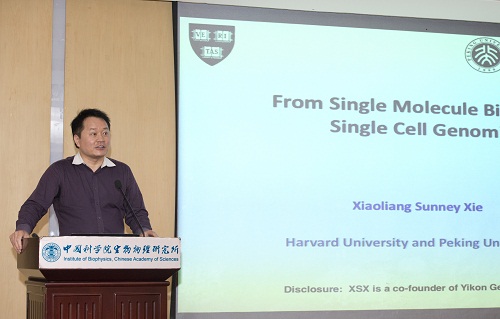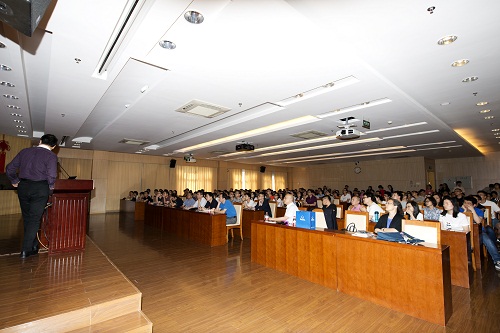Prof. XIE Xiaoliang, member of the US National Academy of Sciences, visited IBP and Gave BEI shizhang Lecture
On May 30th, 2018, at the invitation of The Sixth CASAD Biennial Academic Conference, Professor Xie Xiaoliang, member of the American Academy of Sciences and Mallinckrodt Professor, department of Chemistry and Chemical Biology, Harvard University, visited the Institute of Biophysics.He gave a lecture entitled "From Single Molecule Biology to Single Cell Genomics."
Prof. Xie first introduced his pioneering work of single-molecule enzymology and explained the characteristics of the enzyme's catalytic function at the single molecule level. Professor Xie used single-molecule fluorescence technology to study the law of protein expression in bacteria and analyzed the large intestine from a single cell level. The expression of genes in bacilli was found to be random manner in the expression of proteins in individual cells. Next, Prof. Xie introduced the effects of DNA loops on the transcription process of genes at the single-molecule level and found that DNA loops would spatially hinder the transcription; in the absence of a Gyrase gyro, the DNA will have a positive supercoiled structure. Reducing the rate of transcription initiation and extension, eventually leads to inhibition of transcription initiation. Through these findings, Professor Xie found that the phenomenon of Transcription Bursting was caused by the shedding of DNA from Gyrase gyrosine and the recombination of DNA and the corresponding DNA. Next, Prof. Xie introduced the MALBAC (Multiple Annealing and Looping Based Amplification Cycles) method invented by his research group, and used this method to complete single-cell genome sequencing of human sperm cells. In addition, META method was used to improve the exact rate of the single-cell genome sequencing. Professor Xie Xiaoliang described the use of MALBAC for transcriptomic research, and developed a MALBAC-DT (MALBAC-Digital Transcriptome) method to detect genome-wide transcription-related modules (CTM) and increased efficiency by 50%.
Finally, Professor Xie used the single-cell DIP-C technology to obtain the 3D structure of the human diploid cell genome with resolutions of 100 nm and 20 kb. They found that the two X chromosomes produce different 3D structures due to different active states. In addition, Professor XIE Xiaoliang's group analyzed the 3D genomic structure of olfactory nerve cells and found that there are significant differences between olfactory receptor-related genes and control cells; Professor Xie Xiaoliang’s group undertook research on the 3D genome structure of different cell types at the single cell level. Different types of cells were found to have different 3D genome structures.
Professor XIE Xiaoliang’s report is fruitful in content, well-structured and vivid. The academic atmosphere of the report was strong and participants showed great interests. After the report, participants took questions on issues of interest and conducted in-depth exchanges and discussions with Professor XIE Xiaoliang.

Prof. XIE xiaoliang was giving the lecture

Scene of the lecture

IBP director-general XU ruiming and Prof. XIE xiaoliang

